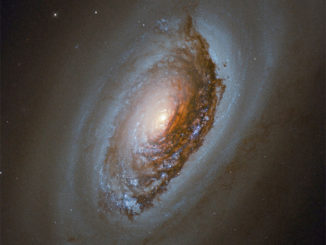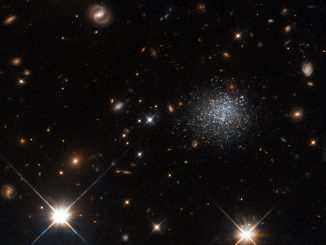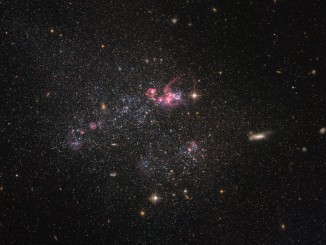
spiral galaxy



Hubble looks into the heart of the Whirlpool Galaxy
The Whirlpool Galaxy, also known as M51, is familiar to legions of amateur astronomers as a relatively faint face-on spiral with a smaller companion galaxy, but the Hubble Space Telescope reveals the Whirlpool in all its splendour, a magnificent spiral studded with countless clusters and dust lanes.

Hubble spotlights irregular galaxy IC 3583
This NASA/ESA Hubble Space Telescope image reveals a delicate blue group of stars — actually an irregular galaxy named IC 3583 — that sits some 30 million light-years away in the constellation of Virgo. This small galaxy is thought to be gravitationally interacting with one of its neighbours, the spiral Messier 90.

The hidden dark side of spiral galaxy NGC 24
This glorious spiral galaxy is known as NGC 24, measures some 40,000 light-years across and lies about 25 million light-years away in the southern constellation of Sculptor. However, there may be more to this picture than first meets the eye: 80 percent of NGC 24’s mass is thought to be held within an invisible dark matter halo.

Hubble sees a lopsided lynx
This galaxy, known as NGC 2337, resides 25 million light-years away in the high northern constellation of Lynx. NGC 2337 is an irregular galaxy, meaning that it lacks a distinct, symmetrical appearance. The galaxy was discovered in 1877 by the French astronomer Édouard Stephan who, in the same year, discovered the galactic group Stephan’s Quintet.

Hubble views a stubborn dwarf galaxy
The fuzzy collection of stars seen in this NASA/ESA Hubble Space Telescope image forms an intriguing dwarf galaxy named LEDA 677373, located about 14 million light-years away from us in the constellation Centaurus. This particular dwarf galaxy contains a plentiful reservoir of gas from which it could form stars, but it stubbornly refuses to do so. Why?

Hubble views face-on spiral galaxy NGC 6814
In this NASA/ESA Hubble Space Telescope image we see the striking face-on spiral galaxy NGC 6814, whose luminous nucleus and spectacular sweeping arms are rippled with an intricate pattern of dark dust. The galaxy was discovered by William Herschel in 1788. NGC 6814 lies 74.4 million light-years away in the constellation of Aquila.

Hubble sees a distinctly disorganised dwarf galaxy
In this Hubble Space Telescope image we see an irregular dwarf galaxy known as UGC 4459, located in the constellation of Ursa Major (The Great Bear). While UGC 4459’s diffused and disorganised stellar population of several billion sounds impressive, this is small when compared to the 200 to 300 billion stars in the Milky Way.

Dwarf galaxy found in deadly gravitational embrace of Sculptor spiral
A dwarf galaxy discovered close to the famous Sculptor Galaxy (NGC 253) by Australian astrophotographer Michael Sidonio has been studied in detail by the 8-metre Subaru Telescope in Hawaii. This fruitful collaboration between amateur and professional astronomers has revealed that the dwarf galaxy, now known as NGC 253-dw2, is being disrupted by the nearby giant spiral.
